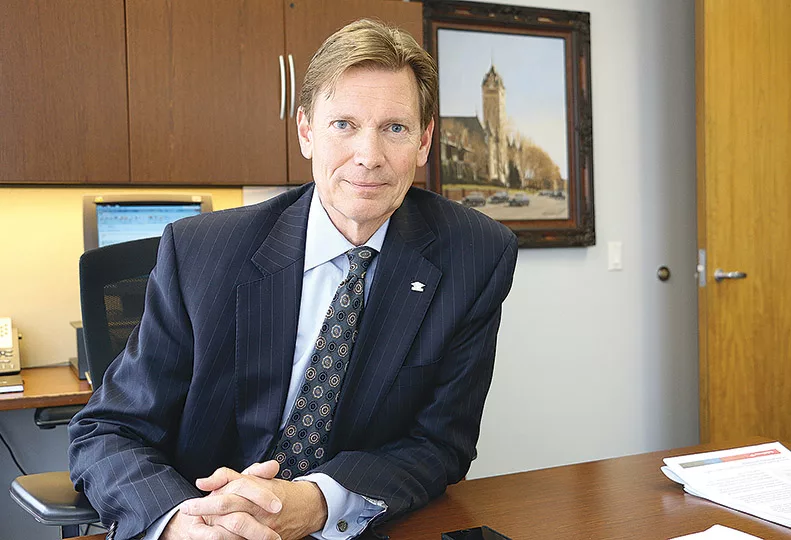
Home » Bank of America looks to build on loan growth in Spokane
Bank of America looks to build on loan growth in Spokane
Institution now employs about 350 people locally

June 19, 2014
Bank of America Corp., the Charlotte, N.C.-based financial institution, increased its small business loans in Washington state by 22 percent last year and hopes to keep that momentum rolling, says Kurt Walsdorf, Spokane-based senior vice president and market president for Eastern Washington and senior vice president and market executive in charge of commercial lending for Eastern Washington and Idaho.
Bank of America was one of 13 national financial institutions that pledged to the federal government and the U.S. Small Business Administration to increase new loans to small businesses nationwide by 2013. The total goal was $20 billion, and Bank of America has exceeded its portion of the commitment by $6 billion, Walsdorf says.
Britney Sheehan, a Seattle-based spokeswoman for the bank, says that the institution doesn’t break down its lending numbers by county, but in Washington state, it lent over $4.24 billion in 2013 and $3.8 billion in 2012.
The total lending amount includes affordable housing and debt and equity loans, small business loans, consumer lending, and economic development programs, Sheehan says. Over the last five years, Bank of America has invested more than $676 billion nationwide in those loan categories, which amounts to about $19 million a day, she says.
Walsdorf says that Bank of America has nine branches and 15 automated teller machines in the Spokane area and employs about 350 people here. That number includes employees at its two Merrill Lynch financial advisory partner offices, one in Spokane and one in Coeur d’Alene, he says. The company’s main offices here are located in the Bank of America Financial Center, at 601 W. Riverside downtown.
Bank of America’s Spokane County deposits as of June 2013 were $738 million according to Federal Deposit Insurance Corp. information, up from $732 million a year earlier. It ranked third in the county on that report, behind U.S. Bank, in second place, and Washington Trust Bank, in first.
The institution also is focusing its efforts on community development here, Walsdorf says, including lending and investing with community organizations here.
“A lot of that lending includes lending in the low- to moderate-income segment, housing projects, that kind of thing,” Walsdorf says. “There are a lot of variables there where the bank wants to continue that growth. Between the community development and small business lending and lending in general, those are the areas we’ve really tried to focus on.”
One of the institution’s community programs involves working with housing organizations, such as Habitat for Humanity, to donate property to members of the military, Walsdorf says.
“We’ve donated seven vacant properties in Washington state,” he says. “I know we’re working on one here in Spokane that hopefully we’ll be able to announce soon.”
In 1977, Congress passed the Community Reinvestment Act (CRA), which monitors the level of lending, investments, and services to low- and moderate-income neighborhoods and agencies. If the regulatory agency finds that a lending institution is not serving those neighborhoods, it can delay or deny requests for mergers, new branch openings, or expand any of its other services.
Bank of America focuses its philanthropic efforts on three areas, Walsdorf says: housing, jobs, and hunger.
“That’s really how we define our foundation priorities,” Walsdorf says. “What we find is, (while) there are so many great causes, we feel those are the three priorities that are going to move our economy forward.”
In its commercial banking operations, Bank of America offers services to companies ranging dramatically in size.
“Within the footprint, we’re basically dealing with companies from $250,000 in revenue to $2 billion in revenue,” he says. “Of course, we also have our consumer footprint, which are our branches, banking centers, and ATMs.”
The institution’s Global Wealth and Investment Management Group also has a presence here, Walsdorf says. That group, which includes Bank of America’s U.S. Trust and Merrill Lynch divisions, deals primarily with investments and estate planning, Walsdorf says.
“It really covers the gamut for anyone from an investment standpoint,” he says.
Bank of America’s two owned Merrill Lynch offices here work with the institution’s business owner clients, Walsdorf says.
“They have a number of financial advisers and deal with our clientele in terms of business owners,” Walsdorf says. “We have a great partnership with Merrill Lynch, which is owned by Bank of America.”
Finally, the bank offers home loans and also representation for what it calls dealer financial services, which are mainly aimed at automotive dealerships.
Bank of America formerly had a few more branches in Eastern Washington, including in Deer Park, Colville, and Moses Lake. Those branches were among 51 branches the institution sold to Seattle-based Washington Federal Inc. late last year.
“The decision to sell those was really a decision to sell those to a community bank instead of closing them,” Walsdorf says. “We’re trying to preserve jobs and continue to have service in those areas … we’re consistently looking to fit the changing customer dynamic. If you look at things like mobile banking and online banking, it’s about finding the right balance and mix between (different ways of) providing access.”
Walsdorf, who will celebrate his 30th anniversary with Bank of America this July, fills several roles within the company. He’s been the market president for Eastern Washington since 2003. As market president, he says he has three main roles. First, working to ensure that clients have access to all the services Bank of America offers. Secondly, he works with employees on being customer-centric, he says, so they are equipped to offer clients the right services and products. Lastly, Walsdorf helps to coordinate the bank’s community efforts, such as foundation giving, volunteerism, and sponsorships.
In addition to the market president role, Walsdorf heads the bank’s business banking group for the Pacific Northwest.
“It’s another kind of a fun part of the job and something I’ve been involved in most of my career,” Walsdorf says. “I’ve kind of grown up in the commercial lending space.”
Walsdorf was born in Wisconsin but moved to Spokane at the age of seven, he says, and was raised in Browne’s Addition. He graduated from Gonzaga Prep High School in 1978 and went on to earn a bachelor’s degree in business and finance from Carroll College in Helena, Mont. He then returned to Spokane as a graduate teaching assistant at Gonzaga University, where he completed a master’s degree in business administration.
“In terms of influence, all the teachers and professors I had at Gonzaga really had an impact on me,” Walsdorf says.
Walsdorf kicked off his financial career working as an unpaid intern for a different bank, he says, before interviewing and accepting a position at Bank of America in Seattle in 1984. He spent some time on the West Side and then in Moses Lake before returning to Spokane, he says.
“It’s been a great 30 years,” he says.
Latest News Special Report Banking & Finance
Related Articles
Related Products


_web.webp?t=1764835652)
